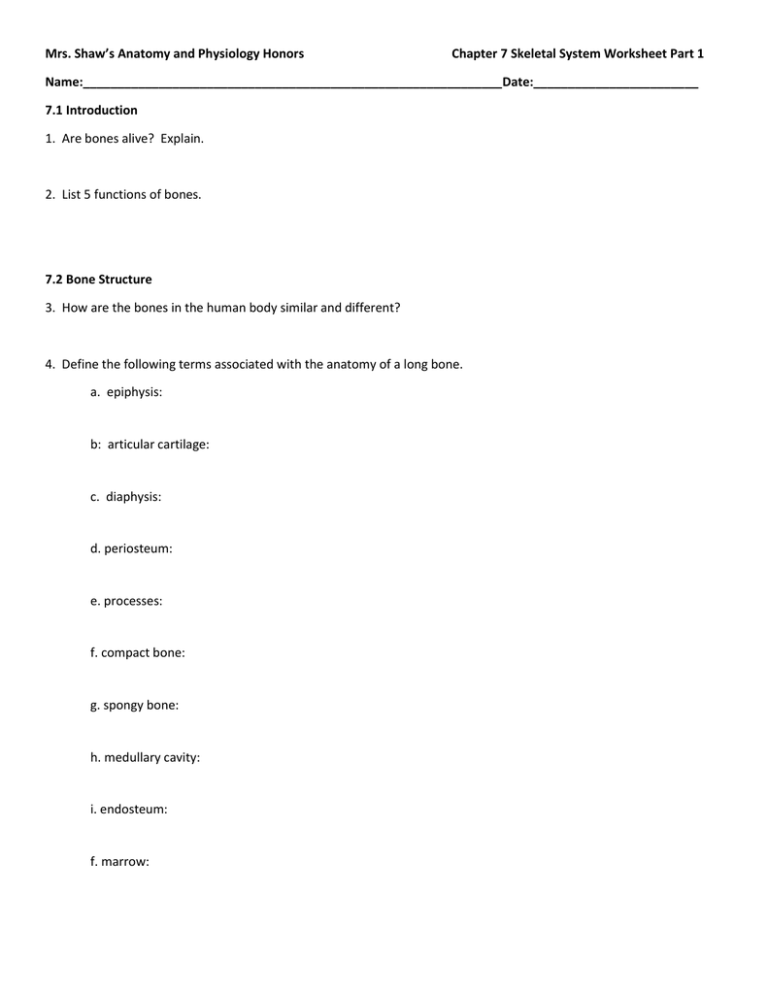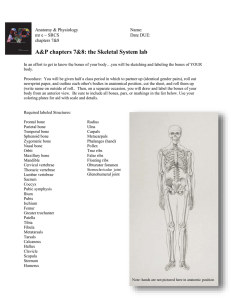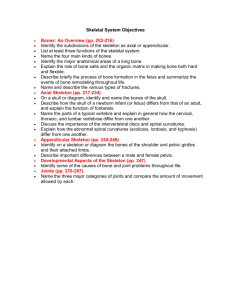Mrs. Shaw's Anatomy and Physiology Honors Chapter 7 Skeletal
advertisement

Mrs. Shaw’s Anatomy and Physiology Honors Chapter 7 Skeletal System Worksheet Part 1 Name:_____________________________________________________________Date:________________________ 7.1 Introduction 1. Are bones alive? Explain. 2. List 5 functions of bones. 7.2 Bone Structure 3. How are the bones in the human body similar and different? 4. Define the following terms associated with the anatomy of a long bone. a. epiphysis: b: articular cartilage: c. diaphysis: d. periosteum: e. processes: f. compact bone: g. spongy bone: h. medullary cavity: i. endosteum: f. marrow: Identify the parts of the Long Bone 1. ______________________________________ 2. _______________________________________ 3. _______________________________________ 4. _______________________________________ 5. _______________________________________ 6. _______________________________________ 7. _______________________________________ 8. _______________________________________ 9. _______________________________________ 10. _______________________________________ Microscopic Structure 1. Bone cells are called __________________________________ and are found in very small, bony chambers called _________________________________. Which form concentric circles around _________________ _________________________ (Haversian canals). 2. What is an osteon? 3. What is the purpose of collagen and inorganic salts in bone tissue? 4. What are perforating canals (Volkmann’s canals)? 5. How is compact bone different than spongy bone tissue? Mrs. Shaw’s Anatomy and Physiology Honors Chapter 7 Skeletal System Worksheet Part 2 Name:_____________________________________________________________Date:________________________ 7.3 Bone Development and Growth 1. When does the formation of the skeletal system begin to grow and finish growing and developing? 2. Differentiate between the formation of two types of bones: Intramembranous bones: Endochondral bones: 3. Define the following terms: Osteoblasts: Osteoclasts: Epiphyseal Plate: 4. What can happen when the epiphyseal plate is damaged before it ossifies? (Look in grey box on page 129) 5. How do osteoclasts, osteoblasts, and hormones help with homeostasis of bon tissue? 7.4 Bone Function – Not every section has questions but you are responsible for reading them all. 6. Describe the 4 basic components of a lever. 7. What is hematopoiesis happen in children and adults? 8. Differentiate between the two types of marrow. 9. Why is blood red? 10. Explain how the parathyroid and bone tissue cells help to regulate your blood calcium levels. 11. What is calcium used for in the human body? 7.5 Skeletal Organization 1. List the parts of the axial skeleton. 2. List the parts of the appendicular skeleton 3. Label the major bones of the axial and appendicular skeleton. Then color the axial skeleton bones red, and the appendicular bones green. (Use the skeleton on page 134 and add the hyoid bone, calcaneus on pg. 154, and the parts of the vertebrae on pg. 142) Word bank Cervical Vertebrae Lumbar vertebrae Thoracic vertebrae Phalanges Fibula Patella Femur Coccyx Clavicle Sternum Cranium Metatarsals Face Ribs Humerus Sacrum Carpals Scapula Tibia Radius Ulna Tarsals Metacarpals Coxa Calcaneus *Memorize these – there will NOT be a word bank on the test. Mrs. Shaw’s Anatomy and Physiology Honors Chapter 7 Skeletal System Worksheet Part 3 Name:_____________________________________________________________Date:________________________ 7.6 Skull 1. The human skull usually consists of _______________ bones that, except for the lower jaw, are firmly interlocked along lines called _________________________. 2. Color and label the Lateral View of the Skull below using the diagram on page 137, Figure 7.11 (this diagram is not an exact replication of this figure but it is very close. Be sure to know all of the parts labeled in Figure 7.11) 3. What is the mandibular condyle? 4. What is the purpose of fontanels in an infantile skull? 5. At what age do these infant fontanels usually close? (You can google this) 7.7 Vertebral Column 6. What are intervertebral discs? 7. What is the function of the vertebral column? 8. Label the diagram on the right using Figure 7.16 on page 142. 1. _________________________ 2. _________________________ 3. __________________________ 4. _________________________ 5. __________________________ 6. __________________________ 7. __________________________ 8. ___________________________ 9. ___________________________ 10. __________________________ 9. How many vertebrae are there in the Cervical vertebrae ___________ Thoracic vertebrae ___________ Lumbar vertebrae ____________ 10. Look at the pictures on page 143 and describe 3 differences between the vertebrae in each of the 3 sections. 11. Differentiate between the sacrum and coccyx. 7.8 Thoracic Cage 12. What is costal cartilage? 13. What is the usual number of ribs and where do they attach in the back? 14. Differentiate between true ribs and false ribs. 15. Where is the xiphoid process located? 7.9 Pectoral Girdle 7.10 Upper Limb 7.11 Pelvic Girdle





